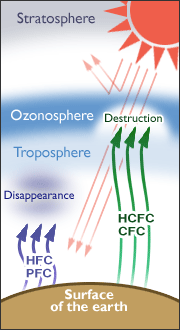Ozone Layer and Freon Gas
Ozone and Freon Gas Usage

Freon is the general name, and chemical name is Fluoric-carbon (chemical materials bonding Fluoride and carbon), among which CFC (Chloro-fluoric Carbon: designated Freon) and HCFC (Hydro Chloro-fluoric carbon: designated Freon) destroy Ozone layer in space. "Specially designated Freon" contains chlorine.
HFC (HydroFluoric Carbon) is called Alternative Freon in general, which does not destroy Ozone layer in space due to no chlorine involved.
Since Ozone gas is unstable material, which is easily decomposed by absorbing solar energy. However, soon after being decomposed, the fluorine atom recombines with oxygen again and returns to Ozone to make balance as nature. In case Freon contains the chlorine atoms, the chlorine separated from Freon by ultraviolet light makes chemical bonding with Ozone. Then, Ozone can not return to original Ozone soon, which results in Ozone-destroy and generates Ozone-hole in space.
Influence of Ozone-destroy
Ozone layer forming in the stratosphere (10 - 50Km from the earth surface) works to protect human beings by absorbing hazardous ultraviolet beam (280 - 320nm of wavelength) in sunlight.
It was clarified in late 1970s that artificial materials of CFC (Chloro-fluoric carbon: designated Freon) that has been consumed in air-conditioners, industrial cleaning agents and form-generation agents have destroyed Ozone layer in space.
Once Ozone layer is destroyed, it is expected to have serious problems on the earth such as increase in covert disease ratio of skin cancer and cataract due to ultra violet light, decrease of photosynthesis, malign effect on DNA and negative impact to natural system.
Protection of Earth Warmth and Ozone Protection Layer
HFC (HydroFluoric Carbon) having Ozone destroy factor "0", a kind of coolant effects on earth warmth, once it is emitted to the atmosphere.

Refrigerator for vacuum system "NeoCold" RTC Series launched by ShinMaywa on February 2004 provides less impact to the earth warmth comparing with the refrigerator using natural coolant when the power consumption is adjusted.
